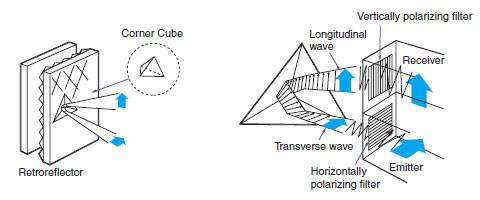What is the MSR (Mirror Surface Rejection) function of Retroreflective Photoelectric Sensors?
Explanation:
1.Light that passes through the polarizing filter at the light emission side becomes horizontal.
2.Light will change from horizontal to vertical if it is reflected on the triangular pyramid on the Retroreflector.
3.The vertical reflected light passes through the polarizing filter at the light receiving side and reaches the light-receiving elements.

Using a Sensor with MSR is ideal for detecting mirrors or other mirror-like objects. By using the principles described above, a Sensor with MSR can detect a mirror-like object as shown in the following figure.

Note: If MSR is not used, the light reflected on the mirror-like object will be received, which will make it impossible to detect the object. The light will not be polarized at the object, and so the polarizing filter at the light-receiving side will prevent the reflected light from being received horizontally. This makes it possible to detect even mirror-like objects.